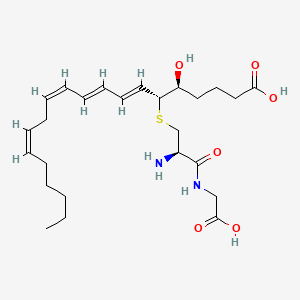| MeSH term | MeSH ID | Detail |
|---|---|---|
| Endotoxemia | D019446 | 27 associated lipids |
| Respirovirus Infections | D010253 | 3 associated lipids |
| Neuralgia | D009437 | 28 associated lipids |
| Sneezing | D012912 | 6 associated lipids |
| Peptic Ulcer Hemorrhage | D010438 | 4 associated lipids |
| Nasal Obstruction | D015508 | 4 associated lipids |
| Respiratory Syncytial Virus Infections | D018357 | 10 associated lipids |
| Asbestosis | D001195 | 8 associated lipids |
| Aspergillosis, Allergic Bronchopulmonary | D001229 | 2 associated lipids |
LTD4
Ltd4 is a lipid of Fatty Acyls (FA) class. Ltd4 is associated with abnormalities such as Inflammatory Bowel Diseases, Inflammatory disorder, Asthma, Pneumonia and Allergic asthma. The involved functions are known as inhibitors, Signal Transduction, Cell Survival, antagonists and Phosphorylation. Ltd4 often locates in Membrane, Tissue membrane, Protoplasm, Cytoplasmic matrix and membrane fraction. The associated genes with LTD4 are ALOX5 gene, UMOD gene, P4HTM gene, RAF1 gene and Homologous Gene. The related lipids are Lipopolysaccharides.
Cross Reference
Introduction
To understand associated biological information of LTD4, we collected biological information of abnormalities, associated pathways, cellular/molecular locations, biological functions, related genes/proteins, lipids and common seen animal/experimental models with organized paragraphs from literatures.
What diseases are associated with LTD4?
LTD4 is suspected in Asthma, Inflammatory Bowel Diseases, Inflammatory disorder, Pneumonia, Allergic asthma, Virus Diseases and other diseases in descending order of the highest number of associated sentences.
Related references are mostly published in these journals:
| Disease | Cross reference | Weighted score | Related literature |
|---|
Possible diseases from mapped MeSH terms on references
We collected disease MeSH terms mapped to the references associated with LTD4
PubChem Associated disorders and diseases
What pathways are associated with LTD4
Lipid pathways are not clear in current pathway databases. We organized associated pathways with LTD4 through full-text articles, including metabolic pathways or pathways of biological mechanisms.
Related references are published most in these journals:
| Pathway name | Related literatures |
|---|
PubChem Biomolecular Interactions and Pathways
Link to PubChem Biomolecular Interactions and PathwaysWhat cellular locations are associated with LTD4?
Visualization in cellular structure
Associated locations are in red color. Not associated locations are in black.
Related references are published most in these journals:
| Location | Cross reference | Weighted score | Related literatures |
|---|
What functions are associated with LTD4?
Related references are published most in these journals:
| Function | Cross reference | Weighted score | Related literatures |
|---|
What lipids are associated with LTD4?
Related references are published most in these journals:
| Lipid concept | Cross reference | Weighted score | Related literatures |
|---|
What genes are associated with LTD4?
Related references are published most in these journals:
| Gene | Cross reference | Weighted score | Related literatures |
|---|
What common seen animal models are associated with LTD4?
There are no associated biomedical information in the current reference collection.
NCBI Entrez Crosslinks
All references with LTD4
Download all related citations| Authors | Title | Published | Journal | PubMed Link |
|---|---|---|---|---|
| Macdonald D et al. | Substituted 2,2-bisaryl-bicycloheptanes as novel and potent inhibitors of 5-lipoxygenase activating protein. | 2008 | Bioorg. Med. Chem. Lett. | pmid:18276139 |
| Smyth TP et al. | A substrate variant as a high-affinity, reversible inhibitor: insight from the X-ray structure of cilastatin bound to membrane dipeptidase. | 2003 | Bioorg. Med. Chem. | pmid:12614884 |
| Maehr H and Yang R | Structure optimization of a leukotriene D4 antagonist by combinatorial chemistry in solution. | 1997 | Bioorg. Med. Chem. | pmid:9113326 |
| Tvaermose-Nielsen O et al. | Discovery of OT4003, a novel, potent, and orally active cys-LT1 receptor antagonist. | 1997 | Bioorg. Med. Chem. | pmid:9061206 |
| Hayashi S et al. | Discovery of {1-[4-(2-{hexahydropyrrolo[3,4-c]pyrrol-2(1H)-yl}-1H-benzimidazol-1-yl)piperidin-1-yl]cyclooctyl}methanol, systemically potent novel non-peptide agonist of nociceptin/orphanin FQ receptor as analgesic for the treatment of neuropathic pain: design, synthesis, and structure-activity relationships. | 2010 | Bioorg. Med. Chem. | pmid:20875743 |
| Uno T et al. | Participation of leukotriene D4 and tumor necrosis factor on lipopolysaccharide-induced airway hyperresponsiveness in guinea pigs. | 1997 | Biol. Pharm. Bull. | pmid:9145204 |
| Tsuji T et al. | Differential effects of beta2-adrenoceptor desensitization on the IgE-dependent release of chemical mediators from cultured human mast cells. | 2004 | Biol. Pharm. Bull. | pmid:15467193 |
| Wulff T et al. | Co-expression of mCysLT1 receptors and IK channels in Xenopus laevis oocytes elicits LTD4-stimulated IK current, independent of an increase in [Ca2+]i. | 2004 | Biochim. Biophys. Acta | pmid:14757222 |
| Kawakami Y et al. | Neutralization of leukotriene C4 and D4 activity by monoclonal and single-chain antibodies. | 2014 | Biochim. Biophys. Acta | pmid:24361619 |
| An S et al. | Molecular cloning of sheep lung dipeptidase: a glycosyl phosphatidylinositol-anchored ectoenzyme that converts leukotriene D4 to leukotriene E4. | 1994 | Biochim. Biophys. Acta | pmid:8054366 |
